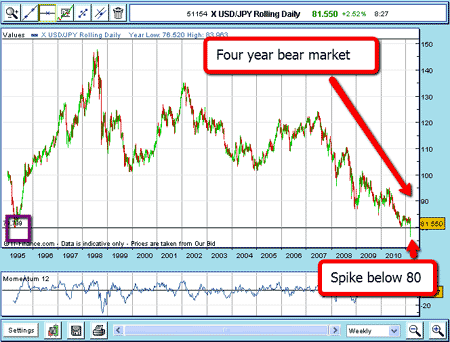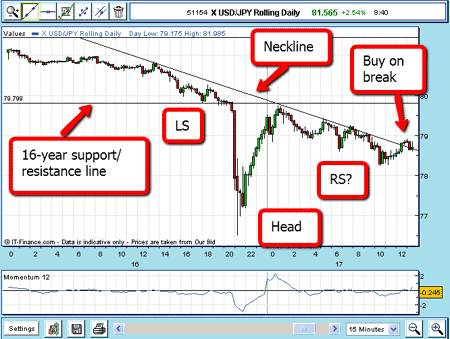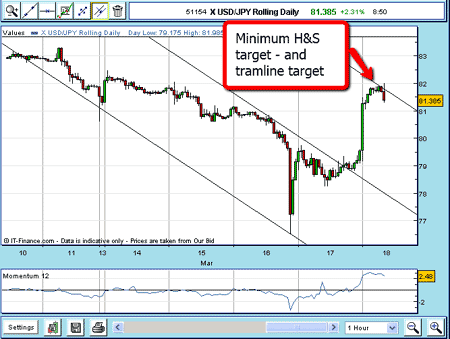Why timing is so important when trading currencies
Currency markets can move extremely quickly, and traders have to be on their toes to spot profit opportunities. Here, John C Burford illustrates the importance of timing, with a trade in the US dollar/Japanese yen market.
Recent tragic events in Japan have served to highlight the fragile state of the nation's economy and the strength of the yen.
Now the world's media have turned their attention to how the country can rebuild, given the high debt that the government has built up to try to stimulate domestic spending and investment.
But with a rapidly ageing population, and a continuation of a deflationary economy, the omens are not good.
Subscribe to MoneyWeek
Subscribe to MoneyWeek today and get your first six magazine issues absolutely FREE

Sign up to Money Morning
Don't miss the latest investment and personal finances news, market analysis, plus money-saving tips with our free twice-daily newsletter
Don't miss the latest investment and personal finances news, market analysis, plus money-saving tips with our free twice-daily newsletter
Meanwhile, the USD/JY rate has fallen to record lows.
Here is the very long-term chart:

(Click on the chart for a larger version)
The last peak was at the 120 area in 2007, and the market has been in an orderly bear market since.
I recently pointed out that the previous low at 80 should provide at least temporary support, and when the market touched that point last October, we did indeed get a bounce, but it wasn't to last, and the market had a sudden plunge down to the 76.50 area last Wednesday.
The spike down on Wednesday was, in my opinion, a final capitulation of the USD/JY bulls as they abandoned ship below the 80 area. That was a huge move of 450 points (5.6%) and just emphasised how much selling took place.
But then the market turned around and finished the day recovering much of its fall:

(Click on the chart for a larger version)
This was the state of play towards the end of Thursday's trading. I had reverted to a short-term 15-minute chart this time because the moves were getting so wide.
I spotted a less-than-perfect head and shoulders (H&S) pattern, but I felt it was a good working model to trade from. The right shoulder was complex, but viable. I drew my neckline and placed a buy order just above in the event of a breakthrough.

Claim your FREE report: The 6-step game-plan for
spread betting profits
The market action right after the spike low was normal for a sharp recovery, which is followed by a slow drifting down which is met by more buying.
Then, overnight, we had the news that the G7 nations had been selling yen. When I arrived at the office early on Friday, this is what my screen showed:

(Click on the chart for a larger version)
The market had exploded up and hit my first target already the H&S projection. This is a very useful method of projecting targets, and so it proved today.
Also, I was able to draw three tramlines on the hourly chart (above), which confirmed the same target area.
So overnight, the G7 had given me a nice 275 pip profit. I think I will have to revise my opinions of governments and central bankers!
Reviewing this rapid trade
The clue that the market was finding a major bottom was the action on Wednesday with the spike plunge below the critical 80 level. That was advertised long ago by Japan's central bank to be the 'line in the sand' and was to be defended.
Then, the rapid rebound back to the 16-year old support/resistance level gave another clue that the bank was, indeed, putting its money where its mouth was, along with the other G7 members.
But to take advantage, you needed to get the timing just right. I had no idea on Thursday night when I placed the trade that more yen selling would happen later that night. But based on the market action Wednesday and Thursday, I had high confidence that the market was turning up.
NB: Don't miss my next bit of trading advice. To receive all my spread betting blog posts by email, as soon as I've written them, just sign up here .
Get the latest financial news, insights and expert analysis from our award-winning MoneyWeek team, to help you understand what really matters when it comes to your finances.
John is is a British-born lapsed PhD physicist, who previously worked for Nasa on the Mars exploration team. He is a former commodity trading advisor with the US Commodities Futures Trading Commission, and worked in a boutique futures house in California in the 1980s.
He was a partner in one of the first futures newsletter advisory services, based in Washington DC, specialising in pork bellies and currencies. John is primarily a chart-reading trader, having cut his trading teeth in the days before PCs.
As well as his work in the financial world, he has launched, run and sold several 'real' businesses producing 'real' products.
-
 How does the Lifetime ISA work? Key LISA rules
How does the Lifetime ISA work? Key LISA rulesWhat is a Lifetime ISA (LISA) and how much could the government bonus boost your savings by? We look at the perks and the pitfalls.
-
 AJ Bell: a fine British fintech going cheap
AJ Bell: a fine British fintech going cheapOpinion Don’t overlook investment platform AJ Bell, a significantly undervalued British business with an excellent financial base